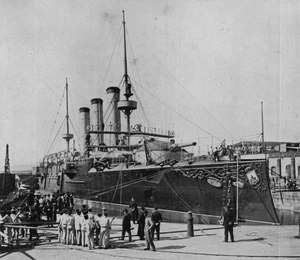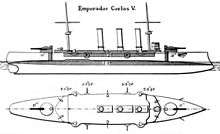Spanish cruiser Emperador Carlos V
Emperador Carlos V was an armored cruiser of the Spanish Navy which served in the Spanish fleet from 1898 to 1933.
 | |
| History | |
|---|---|
| Name: | Emperador Carlos V |
| Namesake: | Charles V, Holy Roman Emperor |
| Builder: | Vega-Murguia Shipyard, Cadiz, Spain |
| Laid down: | 1892 |
| Launched: | 13 March 1895 |
| Completed: | 2 June 1898 |
| Decommissioned: | 1922 |
| Stricken: | 1932 |
| Fate: | Scrapped 1933 |
| General characteristics | |
| Class and type: | Emperador Carlos V-class |
| Type: | armored cruiser |
| Displacement: | 9,090 tons |
| Length: | 380 ft 0 in (115.82 m) |
| Beam: | 67 ft 0 in (20.42 m) |
| Draft: | 25 ft 0 in (7.62 m) mean |
| Installed power: | 18,500 ihp (15,000 ihp on trials with natural draft) |
| Propulsion: | 2-shaft, 4-cylinder vertical triple expansion |
| Speed: |
|
| Complement: | 600 officers and enlisted |
| Armament: |
|
| Armor: |
|
| Notes: | Coal 1,200 tons (normal); 1,800 tons (maximum) |
Technical characteristics

Emperador Carlos V was built at the naval shipyard at Cadiz in Spain, the largest ship built in Spanish yards in this era.[1] She was laid down in 1892, launched on 13 March 1895, and completed on 2 June 1898. She was the only member of her class. Her boilers and machinery were of Spanish construction, her armor German, her stern and stern post British, and her gun turrets, which were installed at Le Havre, France, in 1897, were French.[1] She had three funnels and was weakly armored, relying mostly on her armored deck for protection. Her 11-inch (280-mm) main guns were mounted fore and aft in center-line hooded barbettes.[2] One of her strengths was considered to be her great steaming range.[3]
Operational history
Emperador Carlos V[4] was brand new and not yet operational when the Spanish–American War broke out in April 1898, but she was rushed into service and assigned to the 2nd Squadron, commanded by Rear Admiral Manuel de Camara.[3] This squadron was ordered to steam to the Philippines and face the U.S. Navy's Asiatic Squadron, which had controlled Philippine waters since defeating the Spanish squadron of Rear Admiral Patricio Montojo y Pasaron in the Battle of Manila Bay.
Camara's squadron—consisting of Emperador Carlos V, battleship Pelayo, auxiliary cruisers Patriota and Rapido, destroyers Audaz, Osado, and Prosepina, and transports Buenos Aires and Panay – sortied from Cadiz on 16 June 1898, passing Gibraltar on 17 June 1898.[5] It arrived at Port Said, Egypt, on 26 June 1898, and requested permission to transship coal, which the Egyptian government finally denied on 30 June 1898 out of concern for Egyptian neutrality.[6] By the time Camara's squadron arrived at Suez on 5 July 1898,[7] the squadron of Vice Admiral Pascual Cervera y Topete had been annihilated in the Battle of Santiago de Cuba, freeing up the U.S. Navy's heavy forces from the blockade of Santiago de Cuba. Fearful of the security of the Spanish coast, the Spanish Ministry of Marine recalled Camara's squadron on 7 July 1898,[8] and Emperador Carlos V returned to Spain, where Camara's 2nd Squadron was dissolved on 25 July 1898.[3] Emperador Carlos V spent the last month of the war in Spanish waters, and thus missed combat.
After the war, Emperador Carlos V conducted cruises to show the flag, attending naval reviews in foreign countries, most notably including the coronation of King Edward VII of the United Kingdom in 1902.
In 1914 she was present at the United States occupation of Veracruz.
She was decommissioned in 1922, stricken in 1932,[3] and scrapped in 1933.[9]
See also
![]()
Notes
.svg.png)
- The Spanish–American War Centennial Website: Carlos V
- Conway's All The World's Fighting Ships 1860–1905, p. 382
- The Spanish–American War Centennial Website: Carlos V
- The Naval Historical Center (at http://www.history.navy.mil/photos/sh-fornv/spain/spsh-ag/carlos-v.htm) says that her name was shortened to Carlos V before she was completed.
- Nofi, p. 168
- Cervera's papers, p. 154.
- Nofi, p. 282.
- Nofi, p. 283
- Conway's All The World's Fighting Ships 1906–1921, p. 377
References
- Cervera Y Topete, Pascual. Office of Naval Intelligence War Notes No. VII: Information From Abroad: The Spanish–American War: A Collection of Documents Relative to the Squadron Operations in the West Indies, Translated From the Spanish. Washington, D.C.: Government Printing Office, 1899.
- Chesneau, Roger, and Eugene M. Kolesnik, Eds. Conway's All The World's Fighting Ships 1860–1905. New York, New York: Mayflower Books Inc., 1979. ISBN 0-8317-0302-4.
- Gray, Randal, Ed. Conway's All The World's Fighting Ships 1906–1921. Annapolis, Maryland: Naval Institute Press, 1985. ISBN 0-87021-907-3.
- Nofi, Albert A. The Spanish–American War, 1898. Conshohocken, Pennsylvania:Combined Books, Inc., 1996. ISBN 0-938289-57-8.